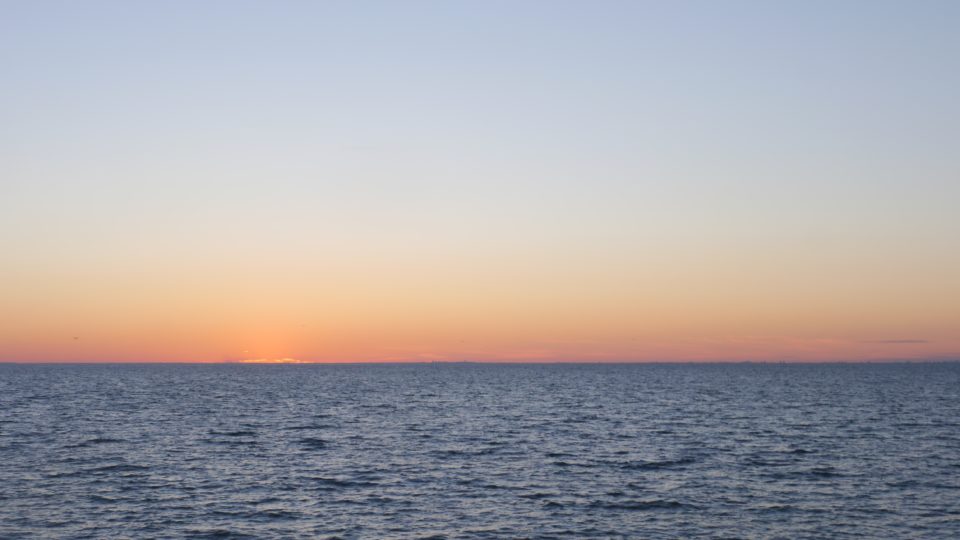
“A clear horizon … invites fresh perception, new inspiration.” ~ Alexandra de Steiguer, Small Island, Big Picture
As part of my visual journaling practice, I pay attention to themes and patterns that show up in my photography. One I’ve noticed recently is that of horizontal lines. In this post, I’ll explore lines as symbols, especially for photography.
Sally Gentle Drew, who co-facilitates the visual journaling workshop with me has this to say.
For me, horizontal lines provide a quiet contrast to the busyness of other types. It seems to say, ‘here, let me organize that content for you’ or ‘let me serve as a boundary so you can better see where this begins and that ends. The horizontal line can also be an edge, heightening my awareness to the present moment – alerting me that a decision may need to be made, a risk may need to be taken, a contrast may exist, or a boundary may or may not need to be crossed.’
Vertical, diagonal and zig zag lines carry a more dynamic energy; they rise, they fall, they say, ‘hey, let me hold that up’ or ‘look here, now there, wait – maybe up here, and down there, and through this’, etc.
When my eye rests on the stable dependability of the horizontal line, something inside feels the space to breathe, feels the time to drift, to imagine, to contemplate potential. I appreciate the quiet encouragement to move at a pace that feels most comfortable to me in that moment; in the knowing that I’ll catch up with the others, and the activity they represent, when I’m ready.
In his online book of photographic psychology, John Suler says that this most basic visual element has two main purposes: to create a sense of direction or a boundary between two spaces. All lines lead the eye. There is a destination.
- Thin – fragile, elegant, delegate, ephemeral
- Thick – strong, bold, make a statement
- Horizontal – restful, calm, quiet, relaxed comfort, stable, secure. absence of conflict, earth bound things
- Vertical – potential energy, dignity, strong, rigid, accentuate height, formality
- Diagonal – unbalanced, restless and uncontrolled energy, convey action and motion, dynamic, create tension and excitement.
- Curved lines – soft, graceful, less definite and predictable than straight lines, express fluid movement, calm or dynamic
- Zigzag – similar to diagonal lines, convey confusion, nervousness, can imply danger and destruction
There are three types of lines that I’ve noticed show up again and again in my photography.
1. The Horizon
The horizon is defined as “the place where the earth’s surface and sky seem to meet” and “the limit of a person’s mental perception, experience, or interest.”
It draws our attention, speaking to a vastness or bigger perspective. The horizon symbolizes something mysterious, beyond our known world. Perhaps the horizon represents our deepest longings, some of which may still be unknown to us. The horizon symbolizes somewhere we’d like to be.
“The unexplainable thing in nature that makes me feel the world is big far beyond my understanding — to understand maybe by trying to put it into form. To find the feeling of infinity on the horizon or just over the next hill.” ~ Georgia O’Keefe
I’m a future-oriented person and feel as if I’m on the horizon of a new phase in my life and business. The future is unknown, yet pregnant with possibility.
2. Edges

Southbrook Winery and Sky
We live in a world of boundaries. borders, and edges – things that separate and things that connect. Stanley Plumly, in his book, The Marriage in the Trees writes,
“In ornithology there occurs the phrase, the abrupt edge, which is the edge between two types of vegetation… where the advantages of both are most convenient.”
Plumly says that natural edges can be very gradual or more abrupt, like a forest’s edge. On the edge can be found the greatest diversity, chaos, danger … and opportunity. I was blown away when I first heard this quote by Plumly. The edge is where things happen. In many of my photographs, lines are edges where things meet or connect, for example, earth and sky, land and sea, built and natural, inner and outer. They show how two come together to create the whole. I think this comes from my desire to see how everything is connected.
The edges in my photographs tend to be thin, and the concept of “thin places” is one that interests me. This is a Celtic term for a place where the boundary between heaven and earth is very thin. (Read: Thin Places in the New York Times and Patricia Turner on “thin places.”
3. Openings

Many of my photographs of lines are cracks in a surface and they’re not often straight, but curving or zig zagging. Cracks are imperfections, often caused by time or stress from external forces. Yet, they’re also openings; places of shelter or possibilities. As Leonard Cohen wisely said,
“There’s a crack in everything. That’s where the light gets in.” ~ Leonard Cohen, Anthem
Seeing openings and possibilities in the unlikeliest of places is a mission of mine. We have to be paying attention. They’re out there. They’re everywhere.
Knowing how lines affect us psychologically and emotionally is helpful when composing an image, as well as reflecting on it later.
Learn more about visual journaling.
This is so interesting, Kim. I have been watching the play of light across the hills and mountains here in Colorado and of course, photographing them. The lines of color and the lines of light have been very evident in my photos. Yesterday, it was cloudy and the layers of clouds were lines and when they lifted a little, there was that line of light between the clouds and the mountains and of course, I had to take some photos! I am very interested in taking the new course with you and Sally. I am not a writer but Visual Journaling sounds like it would be a way to learn how to write my thoughts about a photo with lines being a topic close to my heart.
“The edge is where things happen”. Wonderful! Lines are somehow what make me feel connected to a scene. They give limits, but also create a feeling of protection and reassurance.
Your new workshop sounds like the sort of thing that I would really enjoy and I would love to be notified about joining you and Sally. I enjoyed visiting her blog.
Hi Kim, Mary and Sandra.
I will admit that ‘the space in-between’ has fascinated me for quite some time. Lines are also good at highlighting space – gaps where potential may emerge, if allowed.
I’m so excited about this Visual Journaling venture. Looking back over my life-history-as-it-exists-so-far – themes, patterns, symbols and ‘sleuthing’ have resonated with me forever. ‘Seeing’ can be an enchanting adventure and visual journaling is a fabulous portal to take you there.
Sandra, thank you for visiting my blog site – I’m grateful for that … Sally.
What a thoughtful and inspiring post. I am definitely interested in Visual Journaling. I’ve long been interested in the relationship between image and text.
Very interesting topic! I added my name to your interest list. Thanks!
Lines are a critical element of my photography but I haven’t really delved into why that is so? What is it about geometry and lines that appeals to me so? What are the meanings and emotions behind that attraction? Thank you for putting these questions in front of me.